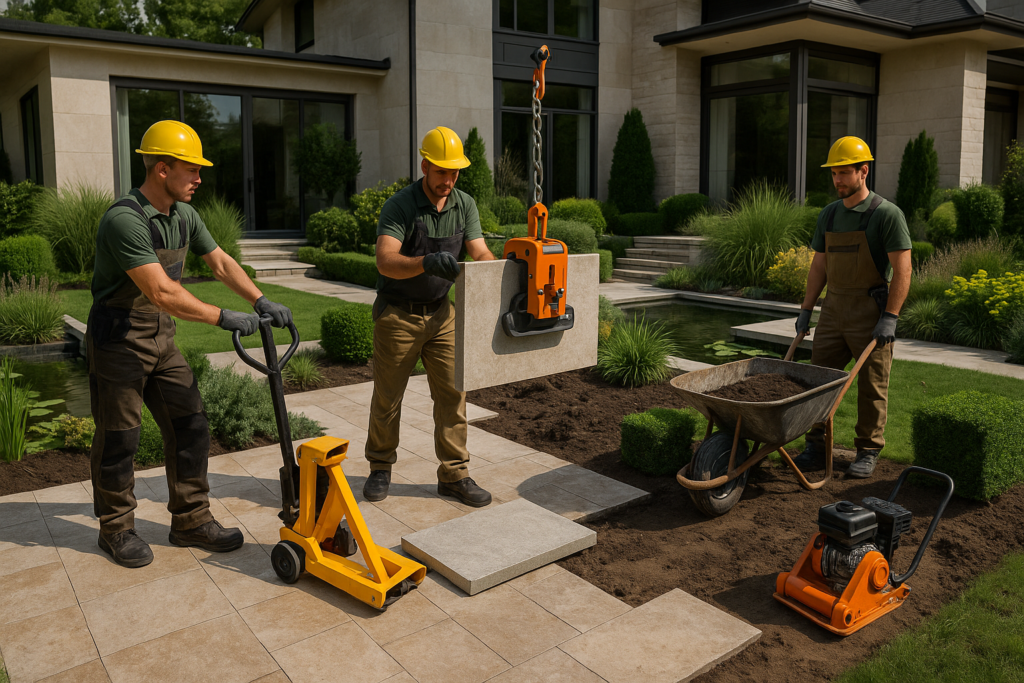Luxury outdoor spaces don’t come to life overnight. Behind every elegant garden, water feature, or outdoor living room is a team of skilled professionals working systematically to bring vision into reality. When crews define landscape processes, they establish the framework that transforms raw land into cohesive environments that combine beauty, function, and sustainability.
From excavation and grading to installing stonework, lighting, and vegetation, the landscape process is as much about coordination and expertise as it is about creativity. In this article, we explore how crews define landscape steps, the tools and technologies that support their work, and the modern trends shaping outdoor environments today.
Why Crews Define Landscape Processes
The landscape industry relies on clear processes because outdoor projects are inherently complex. Crews must balance aesthetics with engineering, ecology with functionality, and luxury with practicality. Establishing defined processes ensures:
- Consistency – Every project follows a reliable sequence of preparation, installation, and finishing.
- Efficiency – Time and resources are managed effectively to avoid costly mistakes.
- Safety – Heavy materials like stone slabs and glass panels require specialized handling tools such as a scissor lifter or slab lifter.
- Quality outcomes – Defined steps ensure landscapes not only look stunning on completion but also mature gracefully over time.
The Core Phases of Landscape Processes
1. Site Assessment and Preparation
The first step is a thorough evaluation of the property. Crews analyze soil conditions, drainage, sun exposure, and existing vegetation. Clearing, grading, and excavation set the stage for functional and aesthetic design.
Builders and crews often collaborate closely at this stage, as discussed in Builders Define Landscape Features in Luxury Homes, where preparation determines the long-term success of sophisticated outdoor spaces.
2. Hardscape Installation
Hardscapes form the backbone of modern landscapes. Crews install elements such as patios, retaining walls, water features, and pathways. Natural stone, granite, and premium woods dominate luxury projects.
To safely handle heavy materials, lifters and cranes are indispensable. For example:
- A scissor lifter ensures secure handling of large stone blocks.
- A slab lifter allows crews to move and install slabs with precision, reducing manual strain.
These tools make it possible to create flawless hardscapes while maintaining worker safety and efficiency.
3. Softscape Development
After structural elements are in place, the landscape is softened with greenery. Crews plant trees, shrubs, perennials, and ground covers to create layers of texture and seasonal interest.
Specimen trees like Japanese maples or olive trees often act as focal points, while native species support sustainability. Crews also integrate turf or artificial grass for usable spaces, ensuring harmony between structure and planting.
This artistry reflects approaches explored in Experts Define Landscape Artistry in Public Gardens, where design and horticulture combine to elevate public and private spaces alike.
4. Infrastructure and Technology
Modern outdoor spaces are no longer limited to plants and pathways. Crews install:
- Irrigation systems for efficient water use.
- Lighting networks for ambiance and security.
- Outdoor kitchens, fire pits, and seating for lifestyle enhancement.
- Smart controls that integrate irrigation, lighting, and even climate control into a single system.
These technologies support sustainability while providing convenience, aligning with principles highlighted in Define Landscape Concepts in Modern Architecture.
5. Finishing and Maintenance Planning
The final stage involves detail work: installing furniture, mulching beds, and ensuring water features or lighting operate smoothly. Crews also provide maintenance guidelines, since even luxury landscapes need ongoing care to preserve their beauty and function.
Tools and Equipment That Support Landscape Crews
Efficient processes depend on specialized tools. In addition to lifters, crews rely on:
- Mini excavators for grading and digging.
- Compactors for stabilizing soil and paver bases.
- Laser levels to ensure precise alignment of terraces and pathways.
- Drones for site surveying and project visualization.
Much like precision in construction, material handling equipment ensures projects meet both safety and design standards.
Trends Shaping Outdoor Landscapes in 2025
Sustainable Practices
Homeowners increasingly demand eco-friendly solutions. Crews implement:
- Native plantings for reduced water use.
- Permeable pavers for stormwater management.
- Solar-powered lighting for energy efficiency.
These approaches echo themes in sustainable planning, as explored in Insulating Glass Unit Benefits for Energy Savings.
Outdoor Living as an Extension of the Home
Luxury outdoor areas are designed as complete extensions of indoor living. Crews build multiple “outdoor rooms,” such as dining terraces, wellness retreats, and entertainment zones with high-end kitchens.
This seamless integration reflects the philosophy of connecting architecture and landscape to enhance lifestyle.
Artistic and Cultural Influences
Landscapes today often incorporate cultural and artistic themes—whether Japanese Zen gardens, Mediterranean courtyards, or modern geometric forms. Crews work with architects and designers to embed artistry into functionality, ensuring spaces remain both visually captivating and usable.
The Value of Professional Collaboration
Defining a landscape is a multidisciplinary effort. Builders, architects, engineers, and horticultural specialists collaborate with crews to ensure every detail aligns with the larger vision. Legal compliance and local permits also guide processes, preventing delays or costly redesigns.
When executed properly, this collaboration results in landscapes that are structurally sound, environmentally responsible, and artistically stunning.
Conclusion: Crews as the Backbone of Landscape Transformation
When crews define landscape processes, they turn architectural visions into tangible realities. Their work involves more than planting trees or laying stone—it’s about orchestrating a sequence of technical, creative, and practical steps that bring luxury outdoor environments to life.
Through expertise, precision tools like the scissor lifter and slab lifter, and collaboration with builders and designers, crews elevate landscapes from raw ground to refined retreats.
As outdoor living continues to evolve, the role of professional crews remains indispensable. They are the hands that execute visions, the minds that solve problems, and the backbone of the luxury landscape industry.

